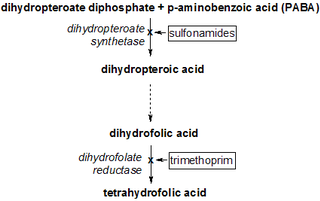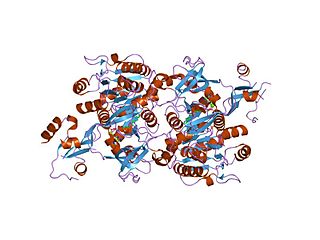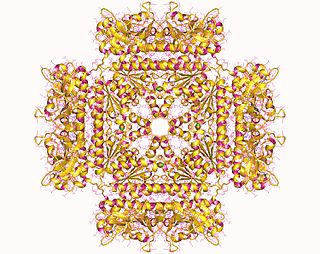| Dihydrofolate synthase | |||||||||
|---|---|---|---|---|---|---|---|---|---|
 Dihydrofolate synthase monomer, E.Coli | |||||||||
| Identifiers | |||||||||
| EC no. | 6.3.2.12 | ||||||||
| CAS no. | 37318-62-0 | ||||||||
| Databases | |||||||||
| IntEnz | IntEnz view | ||||||||
| BRENDA | BRENDA entry | ||||||||
| ExPASy | NiceZyme view | ||||||||
| KEGG | KEGG entry | ||||||||
| MetaCyc | metabolic pathway | ||||||||
| PRIAM | profile | ||||||||
| PDB structures | RCSB PDB PDBe PDBsum | ||||||||
| Gene Ontology | AmiGO / QuickGO | ||||||||
| |||||||||
In enzymology, a dihydrofolate synthase (EC 6.3.2.12) is an enzyme that catalyzes the chemical reaction
- ATP + 7,8-dihydropteroate + L-glutamate ADP + phosphate + 7,8-dihydropteroylglutamate
The 3 substrates of this enzyme are ATP, 7,8-dihydropteroate, and L-glutamate, whereas its 3 products are ADP, phosphate, and 7,8-dihydropteroylglutamate.
This enzyme belongs to the family of ligases, specifically those forming carbon-nitrogen bonds as acid-D-amino-acid ligases (peptide synthases). The systematic name of this enzyme class is 7,8-dihydropteroate:L-glutamate ligase (ADP-forming). Other names in common use include dihydrofolate synthetase, 7,8-dihydrofolate synthetase, H2-folate synthetase, 7,8-dihydropteroate:L-glutamate ligase (ADP), dihydrofolate synthetase-folylpolyglutamate synthetase, folylpoly-(gamma-glutamate) synthetase-dihydrofolate synthase, FHFS, FHFS/FPGS, dihydropteroate:L-glutamate ligase (ADP-forming), and DHFS. This enzyme participates in folate biosynthesis.









